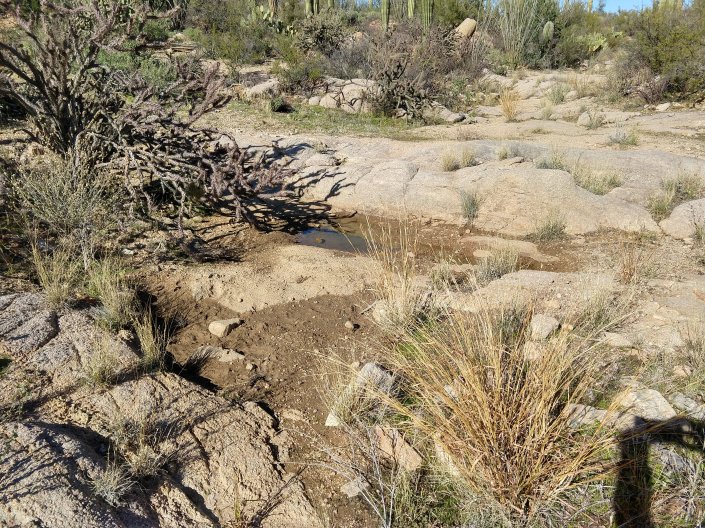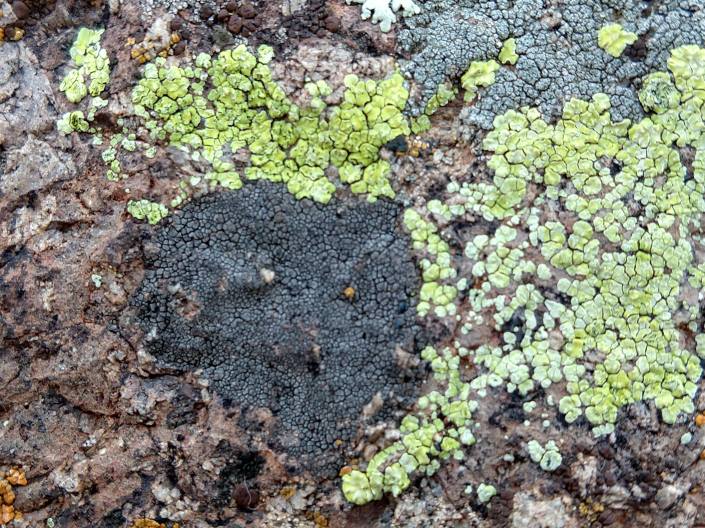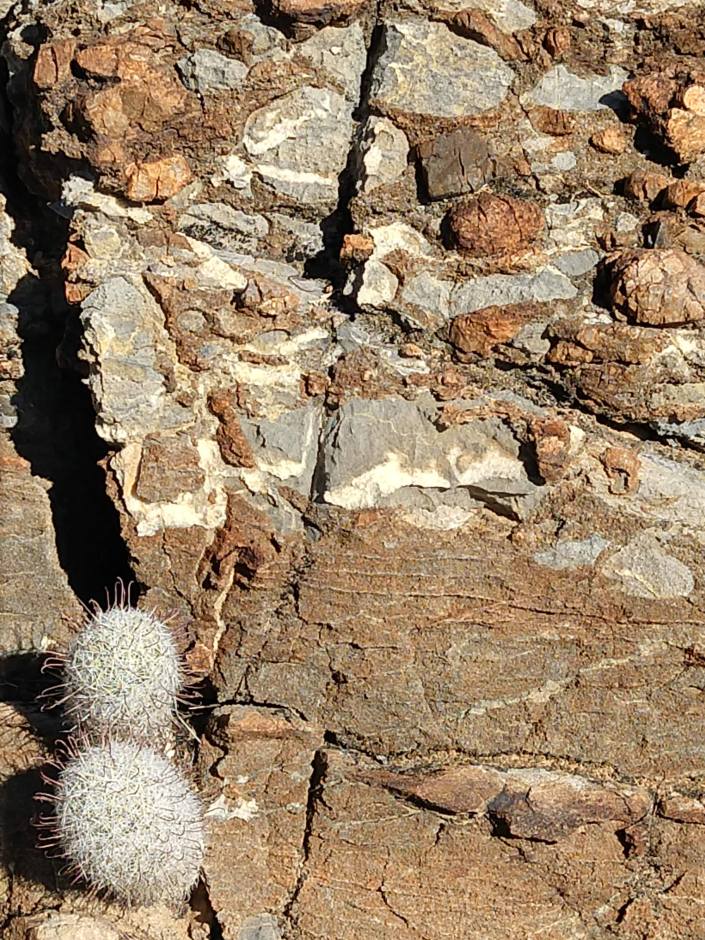Lunch with Desert Lichens-Notes

I am sitting on a carefully checked rock (cactus spines? rattlesnake?), munching on lunch and letting my eyes focus on the rocks that make up most of the surface of the earth here in this dry arroyo. Two friends and I are spending the day meandering with the water way, smelling and watching and feeling our way into a tiny part of this lush land.
When we pass through this desert in a car, we notice nothing. When we hike a trail at our usual rapid and noisy pace, we notice some of the larger, most unusual residents such as the iconic Saguaro cactus that everyone recognizes. If you are very lucky and observant you may see a roadrunner scoot between the cactuses. But there is more here, more than you can imagine.
I love lichens for many reasons, and so will begin telling of desert wonders by introducing you to a very few of the lichen residents. For they are one of the foundations of all life in the desert.

This blue green foliose lives near the floor of the arroyo, so when water moves through from the summer storms it probably gets very wet. Otherwise life is either very hot and dry or quite cold on this rock. These lichens hold moisture, provide food and shelter and add nitrogen to the land, and moderate surface temperatures, just as they do in the greener hills of the Midwest. They help form the biofilm crust that makes a healthy desert ground surface.

Hidden in the lichens and small plants that grow in rock niches are insects, essential for bird and reptile residents. Hawks, owls and small mammals eat the birds and lizards, and they support the coyote, fox and larger animals. All these animals fertilize the land and leave bones, fur and other inedible parts of their meals to return to the soil, replacing nutrients, and so each resident provides something essential for others in a close web of cooperation.

This moss glows with silver light; it drew our attention from quite a distance away. Around the edges were small crustose lichens. (My photo of them was blurry so we can’t see them, sorry. Cell phone cameras are useful but have big limitations that I am not able to overcome.) Since moss prefers less harsh sunlight and more moisture than many lichens, especially the crustose lichens, there are fewer mosses in the desert. This moss is dry now, but turns more green when watered. Often lichens that are dark colored or black have cyanobacteria that give them the dark color. What causes the moss’s dark color? This is the largest patch of moss I have seen so far. Usually there are only small areas of moss in somewhat shady areas. This moss gets a lot of sunshine.
As we munch through our lunch, we notice many birds flying back and forth across the arroyo. There is much twittering in the bushes. The more we look the more birds we see. We are sitting very close to a tiny water hole, and that is why the birds are gathered here.

This tiny puddle and the damp ground around it supports a great many birds, animals, insects and plants. The water is from a rain two days before; there is probably less than a gallon of water here now. Soon this water will be gone but for now it draws dozens of birds and other residents. We see verdin, rock wrens, black phoebe, gila woodpecker, warblers and more. Ants trail across the sand, bees by the hundreds drink from the damp places, butterflies too. Most need some of the water, but it is also a place where many find a meal.

How many species of lichen can you find in the photo above? There are quite a few! This picture shows an area of about 6 inches of rock. Each lichen has a different chemical composition, and may have a different bacteria partner.
The Sonoran desert has over 2,000 species of plants, and over 1,000 species of bees. One hundred species of reptiles here live nowhere else in the world. This bare and harsh looking land is a rich and complex world. Fragile to some stresses, yet resilient and flexible in many ways, the plants and animals of the desert share the lichen’s long adaptation to not only a very hot land, but a home that also is very cold, very dry and very wet at different times.
Below is a desert fern; its leaves are hard, built to resist losing moisture.

The fern is living in a bed of moss, and within the moss are tiny lichen. Lichen surround the moss, in the cracks of the rock. Eventually the moss and fern will go and larger plants take root.
Each time I see a different resident of the desert, I think about what relationships that resident has with any other being nearby. Some relationships are between residents and those who are only here a short time, such as that of the Ocotillo and hummingbirds. Ocotillo blooms in the spring when the hummingbirds that are migrating pass through the area. Nectar from the flowers may be the only food these long distance flyers have. Ocotillo blooms do not depend on rainfall as many other plants’ blooming time does. What conversations have been going on between hummingbirds and ocotillo, for time beyond human understanding, to develop this delicate dance that both support and both benefit from? This is the ever-present story of the desert, and every place on earth, but in the desert there are few or no backup options if one partner fails to participate. Over and over, each animal, plant, insect, fungi and lichen here have a similar story of mutual responsibility and benefit.

A beautiful rock in Sabino Canyon, that tells a complex story about what went on here over a very long time. But hidden in the cracks and shadows is another story; that of the life that begins with tiny spores, isidea and soridea of lichens. Move close, get out your hand lens and look at the rock. There, almost invisible, are the beginnings of a lichen forest. Many years from now the rock may present a different color, then even later, the shapes of crustose lichens will appear fully grown and visible. Insects and birds and lizards and mammals will benefit in many ways, and life will continue in the desert canyon.
Lunch is over, but our walk is not, so my friends and I will leave you, to wander farther up the arroyo. Thanks for joining us!
(Answer to ‘How many lichen species in this picture?’ = I count six! Do you see more?)
Disclaimer: All identifications are tentative. Lichens are very hard to identify, I am not an expert, and my focus is relationships, beauty, and the whole of life around the lichens. If you know what a lichen’s name is, please let me know.
Remember to Look for Lichens!

January 23, 2020 at 12:49 pm
Amazing! Thank you for introducing me to my tiny neighbors. Beautiful pictures. Welcome to the southwest.
LikeLike
January 23, 2020 at 12:57 pm
Hi Susan,
This is such a delight to read and discover, as the snow blankets Wisconsin. It makes me feel warm all over. Thanks for taking the time to share. Deserts are so full of diversity and surprises.
LikeLike
January 23, 2020 at 6:09 pm
The last time I was in the Sonoran desert I knew nothing of lichen. I love finding out that they can survive in this environment. Thanks for the info. I plowed snow today!
LikeLike
January 23, 2020 at 10:50 pm
That’s a very interesting read! Thanks for sharing.
LikeLike
February 29, 2020 at 11:08 am
Thanks everyone for your interest in the Tiny Ones. It is fun to learn about what we had no idea existed, and was right there all the time. Check in again.
LikeLike
August 3, 2023 at 10:35 am
I would like to commend the lichens of the Ironwood Forest National Monument.
https://photos.app.goo.gl/M8qrF4gwcTx5Z9n46
LikeLike
August 3, 2023 at 3:07 pm
Thanks for the tip. When in Tucson I’ll go out and look around. Have been exploring other
areas but that’s a place I’ve been wanting to see anyway.
LikeLike